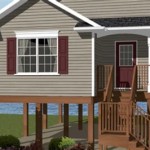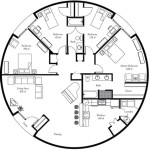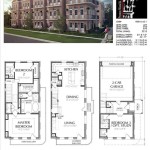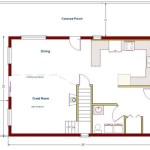Tiny House Plans With Material List: A Comprehensive Guide
The burgeoning popularity of tiny houses reflects a broader societal shift towards simplified living, reduced environmental impact, and greater financial flexibility. Constructing a tiny house demands meticulous planning and precise execution. A crucial element in a successful build is a well-defined set of tiny house plans coupled with a comprehensive material list. This article explores the key aspects of sourcing, interpreting, and leveraging these resources to facilitate a streamlined and cost-effective construction process.
Tiny house plans serve as the architectural blueprint for the entire project. They encompass detailed drawings, specifications, and instructions necessary to guide the construction from foundation to finishing touches. These plans typically include floor plans, elevations, sections, and details of structural elements, plumbing, electrical systems, and interior design. The material list complements these plans by providing a comprehensive inventory of all materials required for the build, including quantities, dimensions, and specifications. Accuracy and thoroughness are paramount in both the plans and the material list, as errors or omissions can lead to delays, increased costs, and structural issues.
Understanding the Components of Tiny House Plans
Tiny house plans are multifaceted documents that require careful interpretation. They are not merely aesthetic renderings; they are technical guides that dictate the precise construction process. Key components include:
Floor Plans: These represent a bird's-eye view of the house, illustrating the layout of rooms, placement of doors and windows, and the overall flow of space. Dimensions are clearly indicated, enabling accurate material calculations. The floor plan also details the location of fixtures such as sinks, toilets, and appliances.
Elevations: Elevations are orthographic projections showing the exterior of the house from different viewpoints (front, rear, left, and right). They depict the roofline, window and door placements, and exterior finishes. Elevations are critical for visualizing the overall aesthetics of the house and ensuring proper proportions.
Sections: Section drawings provide a vertical cutaway view of the house, revealing the internal structure and construction details. They are particularly useful for understanding wall construction, roof framing, and insulation techniques. Sections often include annotations that specify materials and construction methods.
Details: These are enlarged drawings that focus on specific areas of the house, such as window and door framing, stair construction, or connections between structural elements. Details provide precise information necessary for proper assembly and adherence to building codes.
Electrical and Plumbing Plans: These plans outline the layout of electrical wiring, outlets, switches, and fixtures, as well as the routing of plumbing pipes for water supply and drainage. They are essential for ensuring compliance with safety regulations and proper functionality of these critical systems.
The complexity of tiny house plans can vary depending on the design and level of detail provided. Some plans may offer a simplified overview suitable for experienced builders, while others may provide highly detailed instructions for novice builders. It is crucial to carefully evaluate the plans prior to purchase to ensure they align with the builder's skill level and understanding of construction principles.
Deciphering the Material List: A Guide to Accurate Procurement
The material list is an indispensable companion to the tiny house plans. It itemizes all materials needed for the construction project, providing quantities, dimensions, and specifications. A well-prepared material list minimizes waste, prevents shortages, and facilitates accurate cost estimation. Key elements of a comprehensive material list include:
Framing Lumber: This section specifies the type, dimensions, and quantity of lumber required for framing the walls, floor, and roof. Common lumber types include dimensional lumber (e.g., 2x4, 2x6) and engineered lumber (e.g., LVL, PSL). The material list should clearly indicate the grade and treatment (e.g., pressure-treated for ground contact) of the lumber.
Sheathing: Sheathing materials, such as plywood or OSB (oriented strand board), are used to cover the framing and provide structural support. The material list should specify the thickness, grade, and type of sheathing required for each application (e.g., wall sheathing, roof sheathing).
Roofing Materials: This section lists the type and quantity of roofing materials needed, such as asphalt shingles, metal roofing panels, or cedar shakes. The material list should also include underlayment, flashing, and fasteners.
Insulation: Insulation materials are crucial for thermal comfort and energy efficiency. The material list should specify the type of insulation (e.g., fiberglass batts, spray foam, rigid foam), R-value, and quantity required for walls, roof, and floor.
Windows and Doors: This section lists the dimensions, type, and quantity of windows and doors required. The material list should also specify the frame material (e.g., vinyl, wood, aluminum) and glazing type (e.g., single-pane, double-pane, low-E).
Siding: Siding materials, such as wood siding, vinyl siding, or metal siding, are used to clad the exterior walls. The material list should specify the type, dimensions, and quantity of siding required.
Fasteners: This section lists all nails, screws, bolts, and other fasteners required for the construction project. The material list should specify the size, type, and quantity of each fastener.
Interior Finishes: This section lists materials for interior walls, floors, and ceilings, including drywall, flooring, trim, and paint. The material list should specify the type, dimensions, and quantity of each material.
Plumbing and Electrical Supplies: This section lists all plumbing pipes, fittings, fixtures, wires, outlets, switches, and other electrical components required for the project. These lists often require specialized knowledge of local codes and regulations.
The accuracy and completeness of the material list are critical for effective budgeting and procurement. It is advisable to review the material list carefully and compare it to the tiny house plans to ensure that all necessary materials are included. Consulting with local building supply retailers or contractors can help to refine the material list and identify potential cost-saving opportunities.
Leveraging Digital Tools and Resources
The digital age has revolutionized the process of sourcing and utilizing tiny house plans and material lists. Numerous online resources and software tools are available to streamline the planning and construction process:
Online Plan Marketplaces: Several websites offer a wide selection of tiny house plans from various designers. These marketplaces often provide detailed descriptions, reviews, and customization options.
3D Modeling Software: Software programs like SketchUp and AutoCAD allow users to visualize the tiny house design in three dimensions. These tools can be used to create custom plans, experiment with different layouts, and generate accurate material lists.
Material Estimation Software: Specialized software programs can automatically generate material lists based on the dimensions and specifications entered by the user. These tools can significantly reduce the time and effort required to create a comprehensive material list.
Online Building Supply Retailers: Many building supply retailers offer online ordering and delivery services, providing convenient access to a wide range of materials. These retailers often provide detailed product information and technical specifications.
Online Forums and Communities: Online forums and social media groups dedicated to tiny house construction provide a valuable platform for sharing information, asking questions, and seeking advice from experienced builders.
Furthermore, many home improvement stores offer project quote services. One can bring the plans to the store, and they will generate a material list and price quote based on the supplied designs. This can be a valuable tool for cost control, price comparison, and finding alternative material choices that may be more cost-effective.
By leveraging these digital tools and resources, builders can significantly enhance the efficiency and accuracy of the tiny house construction process. Access to comprehensive plans and material lists is a prerequisite for navigating the often complex and challenging process of building a tiny home. Thorough planning and careful execution of these plans are essential for realizing the dream of a sustainable and fulfilling tiny living experience.

Tiny Project House Floor Plans Construction Sketchup

Tiny House Plans Camila

Build A Tiny House For Only 10 000 With These Free Plans Materials List And Design All Building How To Plan

Build Your Own Tiny House How To Minimize The Building Cost Top Ing Home Plans

17 Do It Yourself Tiny Houses With Free Or Low Cost Plans

16x12 Tiny House Plans Design

Tiny House Plans The Project

16 Cutest Tiny Home Plans With Cost To Build Craft Mart
:max_bytes(150000):strip_icc()/ana-tiny-house-58f8eb933df78ca1597b7980.jpg?strip=all)
4 Free Diy Plans For Building A Tiny House

20 X 16 Cabin Loft Plans Tiny House Diy








